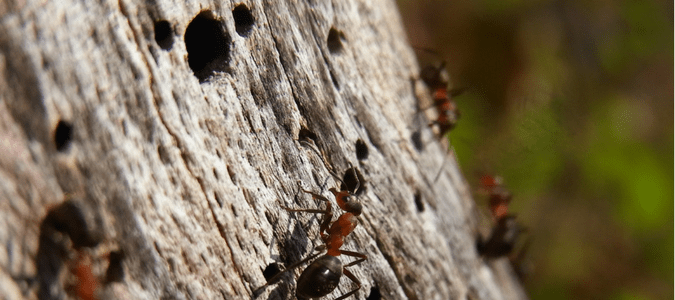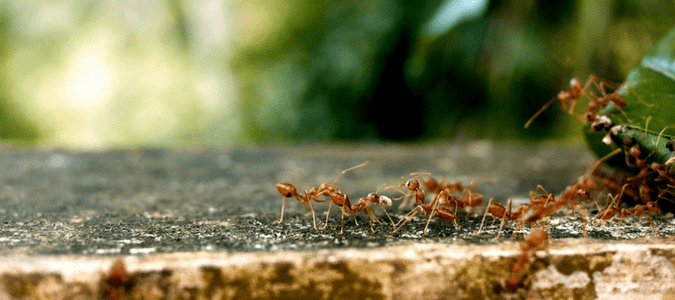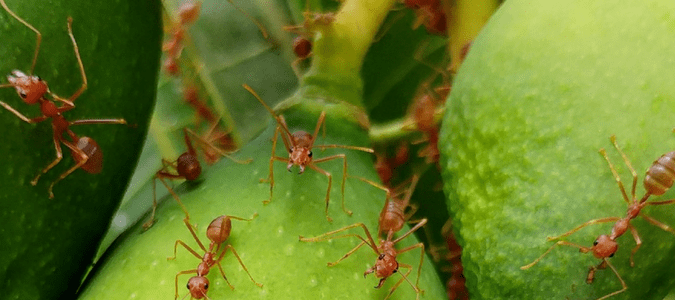
Because of their size, identifying ants can be difficult. Some ant species can only be accurately classified by a pest control professional or under a microscope. However, if you know some key characteristics of different types of ants, you can usually determine which variety you are seeing in your yard or inside your home. Knowing how to distinguish carpenter ants vs fire ants can help you protect your home and your family from painful bites and the damage these pests can do. While carpenter ants are wood-destroying insects, capable of impacting your home’s property value, fire ants inflict their damage through bites that can become swollen, itchy and unpleasant.
The short answer about how to tell the difference between a carpenter ant and a fire ant is in their coloration, nesting habits and behavior. While fire ants tend to be a red-brown color, carpenter ants are generally black, brown or a mix of orange and black. While carpenter ants will bite or sting if threatened, with less need for treatment, fire ants are known by their aggressive behavior and painful stings when their nests are disturbed. While fire ants nest in mounds located on the ground, carpenter ants make their homes in hollow areas in trees, doors, boxes and walls and ceilings of structures.
Keep reading to learn more about how to identify carpenter ants, several different species of house ants, types of ants that bite, and, perhaps most importantly, how to get rid of ants in a room.
Carpenter Ants Identification
Carpenter ants are very common in Texas and other Southern states. These pests look similar to fire ants, but behave like termites, and therefore can be hard to identify. Typically found in trees, carpenter ants can invade both your home and yard. As one of larger ant species, carpenter ants are more of a nuisance than a major source of destruction to your home—unless a homeowner ignores them completely. Termites cause significantly more damage and Texas carpenter ants, in particular, are less destructive than their northern counterparts.
However, homeowners need to ensure these ants aren’t taking up residence in the wood of your home or trees. Carpenter ants will build their nests in solid wood but prefer to find existing crevices in wood, such as hollow doors and hollow walls, or softer materials like insulation or cardboard boxes to make their homes. This ant species is attracted to areas near moisture. If you find them in a home or building, you probably have rotting wood or excessive moisture nearby.
With 18 different recorded species in Texas alone, carpenter ants can be difficult to identify. The most common type you’ll probably see on your property is ¼ to ⅜ inches long with a black abdomen and a reddish-brown head and thorax. That said, winged ants can be black and workers of other species can be yellow and black. Carpenter ants have a pinched waist and elbowed antennae, which will help you distinguish them from termites, which have a broader midsection and almost no separation between the abdomen and thorax. Like some termites, the reproductive carpenter ants are winged and swarm, seeming to appear almost overnight during mating season in late winter and early springtime.
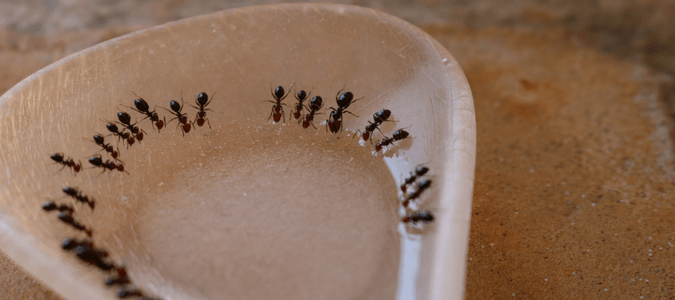
Types of House Ants
Various species of house ants prefer to live with you and your family, whether that means in your home or outside on your property. In addition to fire and carpenter ants, you may find acrobat ants, Pharaoh ants, crazy ants, odorous house ants, rover ant and leaf-cutting ants in your home. Identifying which type you see in your kitchen or your bathroom can sometimes be tricky, so we’ve included some tips to help you distinguish between the different species.
Acrobat Ants
Acrobat ants get their name because of the fact that they raise their heart-shaped gasters into the air in defense when they are threatened. These ants prefer to build their nests in trees, but will also house their colonies in your walls and insulation. Although they are similar in color to carpenter ants, acrobat ants have two pedicels, which are segments located between the abdomen and thorax, whereas carpenter ants only have one. Acrobat ants are medium-sized, while carpenter ants are generally larger.
Acrobat ants don’t cause much damage to your wood, but they can bite you if you disturb their colony. if you want to keep these ants out of your siding and insulation, you can look for and repair any damaged wood, gaps or crevices on your home’s exterior and address moisture problems.
Crazy Ants
Known for their fast, erratic movements, crazy ants have hairs covering their body, which gives them a distinctive appearance. Crazy ants are more prevalent in humid, warm parts of Texas. Different crazy ant species have different colors, from light yellow to dark brown.
The dark brown variety of crazy ant can infest commercial and residential buildings and has been known to destroy electronics and wiring. Some species make their nests in the soil of potted plants. Similar to what you might do to get rid of other types of ants, crazy ant control involves keeping your eating and dining areas very clean, removing lawn debris from the perimeter of the home that can serve as nesting spots and trimming tree limbs and branches to prevent ants from using these to enter your home.
Leaf-Cutter Ants
You might first notice leaf-cutter ants when you see tiny pieces of leaves which appear to be moving on their own across the ground. These strange-looking ants are found in the tropics and throughout the southern United States. Leaf-cutting ants live in the soil with crater-shaped mounds. The leaves they forage are carried back to their nest to enable the growth of a special fungus which is eaten by ants. The worker ants are reddish-brown and have long legs, three sets of spines on their thorax, spines on their heads and a smooth gaster. These ants are common in yards in eastern Texas and in the Hill Country.
Leaf-cutting ants can do significant damage in gardens and to plants typically used in landscaping. These types of ants are particularly difficult to control because treating your plants is only a temporary solution and one which is not effective at attacking the ants’ underground nest. Also, since leaf cutter ants only feed on leaf fungus, they don’t respond to baits that work on other ants, including fire ants. Bait designed to help control leaf-cutter ants may need to be reapplied after about four to six months.
Odorous House Ants
Hiding within and around mulch, stones and other objects in your yard, these medium-sized ants are smooth bodied with a few hairs. Also known as sugar ants, coconut ants and stink ants, this species smells like licorice when smashed. As one of the nicknames suggests, these ants have a sweet-tooth which can bring them in close proximity to humans.
Odorous house ants don’t transmit disease, can’t cause structural damage and won’t even bite. If you get tired of seeing these ants in your kitchen, you can make sure to thoroughly clean your surfaces after meals and remove standing water in and around your home. Since these ants can nest inside mulch and potted plants, you may want to move containers away from doors and entryways and limit your use of mulch to prevent these insects from coming indoors.
Pharaoh Ants
Pharaoh ants are tiny—only 1/32 inches long—and are drawn to foods high in sugar and proteins. These ants nest in dark, narrow spaces, inside cracks in walls and within cardboard boxes. This type of ant is sometimes referred to as a sugar ant, although this a common name used to describe many of the small types of ants that are drawn to sugary foods. The best way to control any damage done by this ant species is to use specially-designed baits.
Rover Ant
Rover ants are almost the same size as Pharoah ants and dark brown in color. This ant species, which pest professionals are seeing more and more, is also attracted to sugary foods and nests in the ground. However, rover ants will also nest in walls and can be seen on sidewalks and the edges of homes as they forage for food. Although these ants do little structural damage and don’t bite humans, homeowners consider them a nuisance. Rover ants have proven to be one of the more difficult ants to control because they are not attracted to baits used for other species. If you want to get rid of rover ants, you can try replacing water damaged wood and treating potential nesting areas. Indoors, you can apply gel bats or dust in electrical sockets.
Types of Ants That Bite
While some ants bite and release venom into the wound, others sting with the point of their abdomen and then release a venom. Acrobat ants sting their prey, as do harvester ants. Harvester ants sting multiple times, as do fire ants. Field ants bite people and pets. Crazy ants also bite, as do carpenter ants. Because of a carpenter ants’ size, their bite can hurt a bit more. However, no ant bites hurt as much as a fire ant bite.
Fire Ants
You know when you’ve been stung by a fire ant because it feels as though you’ve been touched by a hot poker. While only about one percent of the population is allergic to fire ants, multiple bites or stings can cause a reaction, and sometimes a severe one, in anyone. Stings can leave a white pustule on the skin.
There are five different species of fire ants: native Southern fire ants, tropical fire ants, desert fire ants, little fire ants and red imported fire ants. While most people think of the bright red ants when they think of fire ants, these insects range in color from bright red to black and vary in size from ⅛ to ¼ inch long. The red fire ant is the only species which is non-native to the United States. As many differences as all of these species have, these ants have some similarities, such as the bends in their antennae, which have 10 different segments.
Fire ants can also be identified by their nests, which range from small little mounds to larger anthills up to 18 inches in height. These structures don’t have an opening at the top and are usually found around moist areas in your yard after it rains and around riverbanks or other bodies of water in warm climates. When a fire ant nest is disturbed, the colony will quickly swarm out to defend it. If you poke a nest with a stick—not that we would recommend it—be sure to back away quickly and remove the stick from the nest, because fire ants can climb the stick quickly. A fire ant swarm is almost instant, whereas other ants take a little longer to respond.

How to Get Rid of Ants in Room
Once you realize that you have an infestation of ants, the next question you probably have is: “What can I do about it?”. Like termites, you can sometimes find carpenter ants near small piles of frass, which resembles sawdust. The ants push the frass, which is a combination of wood shavings and fragments of dead ants and other debris, out of a small hole in the nest chamber to make room inside of the nest.
Eliminating these pests from your home can be tricky. You can drill into your walls and use pesticides injected into the walls of your home if that is where the nest is located. However, you need to apply any treatments carefully and follow the directions on the label. Baits usually the most effective alternative to drilling into your walls.
There are also other things you can do inside your home to make it less attractive to ants. Don’t leave dishes in the sink and make sure to run the disposal to thoroughly dispose of any and all food that might attract ants. Make sure your food is in tightly sealed containers in your pantry. Wipe down all counters to ensure food residue is cleaned up.
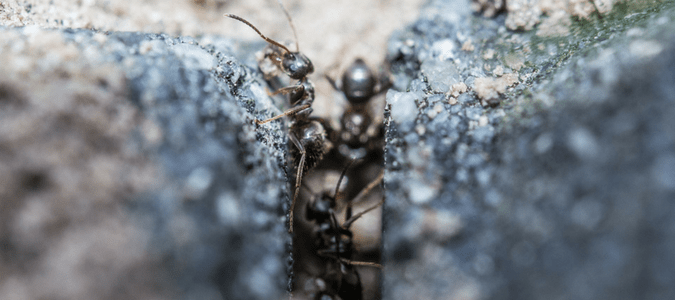
How to Get Rid of Ants Outside
Sometimes, changing the conditions of your yard can help rid your property of these unwanted pests. Many ants are attracted to moisture, so you may need to change the amount of irrigation your yard receives, or check to see if there are any leaks that are attracting them.
Removing stacks of firewood, fallen limbs and leaves from your yard can help. Cut back and trim vegetation from your home. Overhanging tree limbs can be an easy way for ants to find their way onto your roof, so regular pruning of your trees and shrubs can make it a little harder for ants to get onto your living structure.
Ensure that all garbage is contained and not left out in the open for ants to feed on. Some types of mulch attracts ants, while others have been found to repel them. Also, if you leave pet food (or any kind of food) outside, you can be unknowingly attracting ants.
Seal windows and doors to keep ants out. Doing so will also help keep your electric costs down.
In addition to making your yard less attractive to ants, pesticides can also help control these pests outside. Similar to baiting ants on the inside of your home, you can also place bait along their trails, which can then be carried back to the nest.
Ants Are No Match for ABC
Most homeowners don’t have the time or desire to become experts on ants and which control measures work best for which species. The professionals at ABC Home & Commercial Services can apply their extensive entomological knowledge to help identify and treat any ant problems you might be having in your home or yard. Our experts will work with you to come up with a customized treatment plan to target the particular ant that you are having problems with and provide you with suggestions on how to keep ants out of your home in the future.
